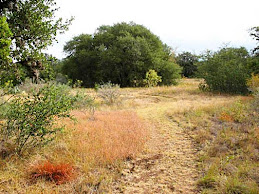So many of you have kindly sent condolences over our situation here--thanks. I will never take running water for granted ever again!

This is the Frio River--or what's left of it--and I'm standing on both banks. Farmer Rick and I were mystified last weekend when a commercial river shuttle dropped off two tubers that looked to be in their 70's at our crossing. I hope someone told them it would be a long, hot, rocky walk back to their car toting those inner tubes!
Compare this with last summer's shot of the same
river. When a river gets shallow and warm, fish die, algae grows, bacteria breeds.

Here's a rare glimpse into our dry well, which is basically empty save for a couple of gallons in the bottom. Many of you out in blogland may not even know where your water comes from--you just pay the city each month and it miraculously comes out of your tap when you turn it on.
Some of you may have your own well that's just a teeny pipe that encases a hole bore through hundreds of feet of earth like an iron straw sucking at the water table. If your pump went out you could get one of those old-fashioned hand pumps to draw the water up.
We have a shallow well that was hand dug through limestone by a pioneer pick axe in the 1860's, later encased with concrete. Where that ends there is a dark emptiness--a narrow horizontal cavern--where the water usually flows just like the nearby river it undoubtedly feeds. You see, an aquifer is like a large rock sponge. Some of the holes are as small as your pinkie, and some of them are underground lakes you could swim in.
The hole below the cavern is where the water is usually stored when the spring is flowing. The pioneers would have hauled it up with buckets and ropes over a wood beam, wishing well style. Assuming your bucket held a gallon, that's 8 pounds to haul up and carry to wherever you needed it. At some point the submersible pump was invented and that's what you see going down on the left side. It has to be
submersed to run. We've turned ours off.
Think about all the ways we Americans use water: flushing toilets, cleaning house, bathing, cooking, household drinking, washing dishes, doing laundry, washing cars, keeping lawns, gardens, animals alive, recreation if you own a pool. How much would you use if you had to pull every bucket up yourself? What would you do if suddenly you had none?
We are bathing with wet wipes. Since I work from home, I wash my hair only when I know I'm going to be seen, about once a week. We drink and cook from bottled water. Fortunately we have a lot of dishes and clothes. I may soon have to drive to another town to use a laundromat and resort to paper plates. That little puddle is managing to keep our animals watered--so far. We can only hope for rain.
I've begun to realize Life, as we've known it, is pretty luxurious compared to what the pioneers must have experienced. I think about all the people today in third world countries who live on about 3 gallons of water--or less--per person per day and that water might even be as skanky as what's in our river right now.
So, the next time you turn on your faucet be conservative with your use, and remember to be thankful!
 It's neat to discover something I missed before, like how the agave plant leaves an impression of itself. I checked all our agave plants, and every leaf holds a record like this of its unfurling growth. Being succulents, they have saved up for the rainless days.
It's neat to discover something I missed before, like how the agave plant leaves an impression of itself. I checked all our agave plants, and every leaf holds a record like this of its unfurling growth. Being succulents, they have saved up for the rainless days.










































